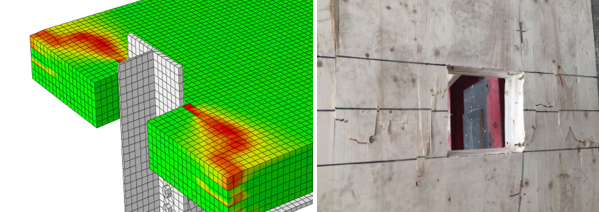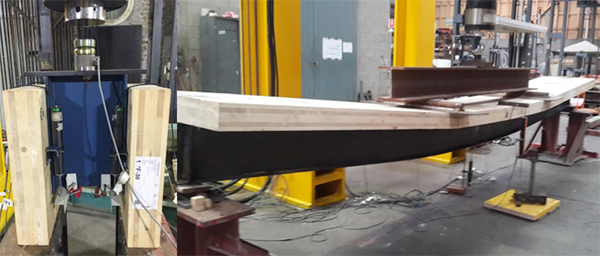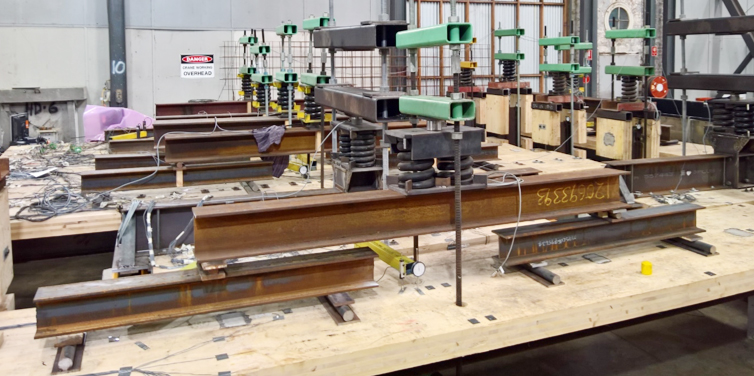The future is multiple: Hybrid and composite steel-timber-concrete structures
 The future is multiple: Hybrid and composite steel-timber-concrete structures
The future is multiple: Hybrid and composite steel-timber-concrete structures
The question is: Can timber as a lightweight and sustainable construction material – albeit with inherent shortcomings- be efficiently used in conjunction with steel and concrete to develop robust and environmentally friendly structures?
The answer, according to exciting CIES research, is yes.
The advantages of wood as a lightweight and renewable building material with little waste and ability to sequester carbon dioxide have been long-established. Moreover, advancement in adhesive and manufacturing technology has made it possible to fabricate very large yet lightweight engineering wood panels (EWP) with enhanced mechanical properties, dimensional stability and a strength-over-density ratio comparable to steel.
Accordingly, some experts regard the use of sustainably managed timber and engineered wood panels instead of energy and carbon intensive construction materials (such as steel and Portland cement concrete) as the only truly sustainable solution for reducing the intrusive impact of the construction industry on the environment.
However, timber remains a natural construction material with complex anisotropic behaviour (wood is stronger along the grain than across it), limited strength and very low elastic E and shear G moduli - compared to steel and concrete. On top of these shortcomings, wood is also sensitive to harsh outdoor environmental conditions.
Completely replacing steel and concrete structures by timber buildings is probably not currently feasible, not just due to timber’s inherent ‘shortcomings’, but also due to a limited supply of construction quality timber in sustainably managed forests. However, available technologies in the timber and construction industry, along with increased investment in those forests, could manage the rise in timber demand, should steel and concrete be partially replaced by timber.
CIES’s Associate Professor Hamid Valipour has spent the past six years of his research career developing, testing and numerically simulating (Fig. 1) innovative hybrid/composite timber-concrete and steel-timber connections and structural systems, thanks to a School of Civil and Environmental Engineering start-up fund and a large Australian Research Council Discovery grant (DP160104092).
Hamid and his CIES colleague Laureate Professor Mark Bradford (chief investigators on DP160104092) have demonstrated the feasibility and superior structural performance of the innovative steel-timber systems compared to conventional steel-concrete composite by short- and long-term push out and bending tests on beams and beam-to-column connections (Figs. 2 and 3).
Currently, buildings consist of reinforced concrete or steel-concrete composites, cast in situ. Concrete is poured into formwork and propping is then required for at least a week. This is a wait of at least 10 days between storeys. Building with steel-timber composites means there is no waiting and upward construction can be seamlessly ongoing.
Alongside no wait is less weight. This reduces cranage and injury risk. Steel-timber composites increase efficiency of moving, lifting and placing panels.
Therefore steel-timber composite floors can significantly increase speed of construction and reduce the noise and pollution associated with construction activities.
The innovative composite systems developed by Hamid and his research team can be easily dismantled at the end of building service life that will, in turn, significantly facilitate recycling, reusing and/or repurposing of the construction materials and hence reduce construction wastes.
Despite numerous advantages, so far only a few steel buildings with cross laminated timber floors have been built around the world, and the enhancing effect of composite action has been mostly ignored in the design of these buildings. But Associate Professor Valipour is confident that in the near future more buildings and designers will take advantage of hybrid steel-timber-concrete systems, such as the ones developed and tested by his research group at CIES.
For more technical information on Associate Professor Valipour’s research – see https://www.sciencedirect.com/science/article/abs/pii/S0950061819318276
Interested industry colleagues should contact him directly.

Fig. 1 Contours of tensile damage index in the outer lamella of the cross laminated timber (CLT) slab versus crack pattern observed in the laboratory experiments

Fig. 2 Short-term push-out and four-point bending tests

Fig. 3 Long-term push-out and four-point bending tests





